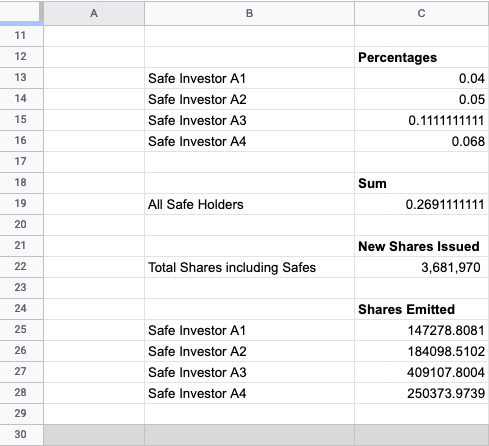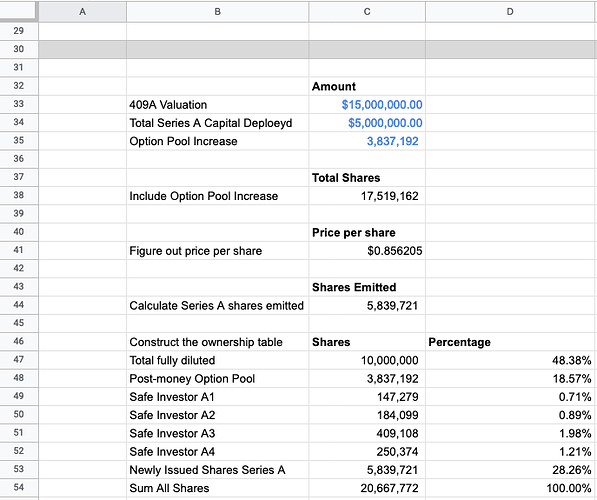This is for founders or investors who are having a conversation around option pool sizes. If you are a founder who wants to understand how many shares you can have to offer new employees joining your company, this conversation is crucial. For investors who want to understand how their investment affects voting power in the organization, this knowledge is a must-have.
Just show me the app that does this
![]() Sign up for a 7 day free trial (usually most companies charge $200/month for this): https://portal.founderskit.org
Sign up for a 7 day free trial (usually most companies charge $200/month for this): https://portal.founderskit.org
First step is to identify the Total Outstanding Securities value for cell C3. This is initially how many shares got created when you first incorporated your company. You can inspect the Certificate of Incorporation document (also known as the Articles of Incorporation) to get the exact number.
| Term | Definition |
|---|---|
| Principal Investment Amount | How much money the VC has deployed into your round |
| Valuation Cap | One of the variables defined in the Post-money Safe contract that you would be signing with your investor. The Valuation cap is the maximum valuation at which an investor can convert a SAFE into equity: a pre-negotiated amount that serves to “cap” the conversion price once shares are issued. |
The assumption here is that you as the user are a founder in a company that is in stage pre-seed or seed stage. You would like to know how many shares are created in each step of the fundraising process. By going through the rest of this Spreadsheet, you will know exactly that amount and you will also know post Series A round, what will be the percentage breakdown for each shareholder added to the cap table as it relates to your current set of Shareholders.
Having this intel is valuable because these shares represents voting power in the organization. Let’s say down the road your company becomes one of the hottest Unicorns in Silicon Valley. It could mean the difference between your investors deciding to have you company acquired for $100k vs you keeping the company until it reaches over 10 billion USD in valuation on the public market

After you have filled out cells D7-D10 and E7-E10 you will see cells C13-C16 be populated with the percentage figures. These percentages represent the ownership that Safe Investors will get immediately prior to the close of the first Priced Round, which is subsequent to the Safe round.
If this is your first time being a founder, it is worth noting that Safe Investors aren’t actually issued shares when the Safe contract is signed by both counterparties. Think of the Safe contract more like a derivative, where the shares are issued in conjunction with a Priced Round. The difference between a Non-Priced Round and a Priced Round is that a your company’s valuation is determined by a Certified 3rd party in a Priced Round.
The next sections show you the Sum of the Percentage Points, New Shares Issued, and New Shares Emitted for each Safe Investor. However, we are unable to figure out the percentage ownership breakdown until the close of the priced round which is beyond the grey divider line.
Finally, provide the inputs for expected 409A valuation. The simplest way to estimate this is to measure the expected EBITDA of your company when you finally raise a priced round (typically 1-1.5 years from the incorporation of the company) then multiply it by your industry multiplier. Enter that value into cell C33.
Next enter the expected value for Series A capital deployed. For Series A (Priced) Rounds, statistics show for years 2022-2023 number is typically between $10M and $30M
The Option Pool Increase Cell C38 is actually a 2 step process. First you must pick the expected value of the Employee Option Pool percentage which is specified in the contract of the Term Sheet.
Statistically, this value is either 10%, 15% or 20%. In our example lets assume it is 20%. In order to figure out the number for C38 you would divide NumShares / (1 - .2). This will get us close but is not the exact amount.
In order to get the exact amount, you will need to increment the value of Cell C38 until D48 equals exactly 20.00%.
The reason is because in order to to find Price Per Share Cell C41, the equation must take into account the total number of Shares, which is dependent on the value you entered for Option Pool shares.

